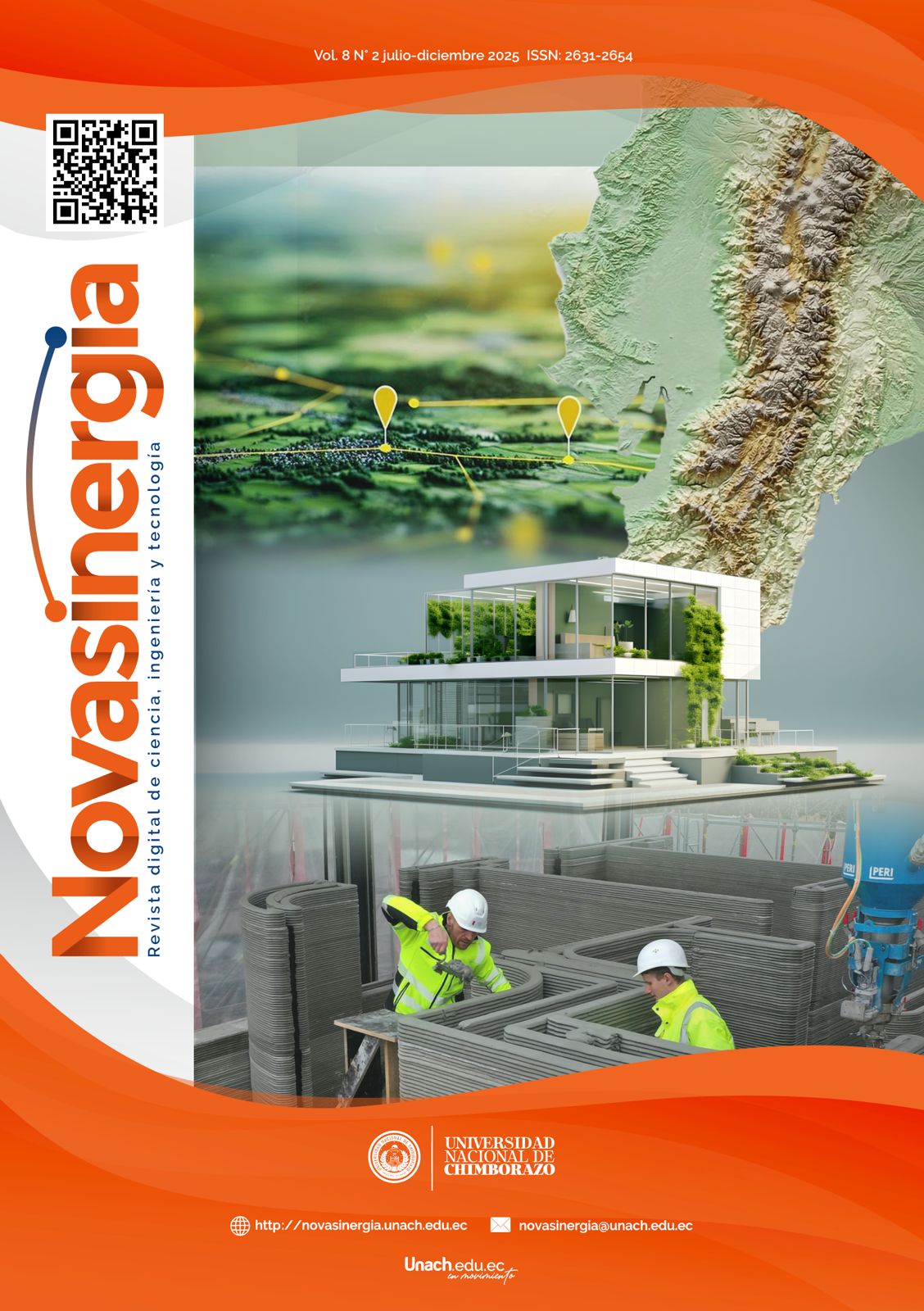Environmental and thermal impact of materials in social housing by climate region in Ecuador
DOI:
https://doi.org/10.37135/ns.01.16.10Keywords:
confort, environmental impact, reciclability, sustainability, social housingAbstract
This study evaluates the environmental and thermal impact of materials used in social housing, considering the distinct climatic conditions of Ecuador's Coast and Highland regions. Building Information Modeling (BIM) and Life Cycle Assessment (LCA) tools were applied to compare two housing prototypes with identical morphology but located in Guayaquil and Quito, respectively. Results indicate that in the Highland region, the thermal envelope must be reinforced to reduce heat losses, while in the Coast region, it is necessary to mitigate solar heat gains. Up to 25% differences in recyclability and 20% in structural mass were identified between regions. The thermal comfort requirements varied significantly, suggesting that material selection and construction strategies should be adapted to the local climate context. The study concludes that social housing programs require a region-specific approach in both materials use and design, and it proposes technical and regulatory guidelines differentiated by climatic region
Downloads
References
.[1] D. Bravo-Martínez, J. Torres-Quezada, y R. Panchana Cedeño, “Análisis del confort térmico en viviendas sociales con diferentes sistemas constructivos en el clima cálido-húmedo de Ecuador,” GWJ, vol. 6, no. 2, p. 78, ago. 2023, doi: https://doi.org/10.53313/gwj62078.
.[2] K. Tituana-Tituana y V. Guillén-Mena, “Análisis de percepción de confort térmico de edificaciones residenciales en la ciudad de Loja basado en la Norma Ecuatoriana de Eficiencia Energética,” re, vol. 21, n. 1 pp. 122–132, jul. 2024, doi: https://doi.org/10.37116/revistaenergia.v21.n1.2024.647.
.[3] B. Baptista, N. Tala, S. López, P. Henriquez, W. Dalaison, y C. Saldías, “Transformando la construcción en América Latina y el Caribe: digitalización e innovación como claves para la sostenibilidad,” Inter-American Development Bank, nov. 2024. doi: https://doi.org/10.18235/0013226.
.[4] L. Godoy-Vaca, E. C. Vallejo-Coral, J. Martínez-Gómez, M. Orozco, y G. Villacreses, “Predicted Medium Vote Thermal Comfort Analysis Applying Energy Simulations with Phase Change Materials for Very Hot-Humid Climates in Social Housing in Ecuador,” Sustainability, vol. 13, no. 3, p. 1257, ene. 2021, doi: https://doi.org/10.3390/su13031257.
.[5] G. Manzaba Carvajal, M. Sánchez Padilla, R. Valencia Robles, y C. Palacios Portes, “Escenarios Post-Pandémicos de la Regeneración Urbana en Avenida Delta, Guayaquil: adaptabilidad del espacio público y disgregación de la banda de equipamiento y servicios,” en XV SIIU, 2023, doi: https://doi.org/10.5821/siiu.12685.
.[6] G. Manzaba Carvajal, R. Valencia Robles, M. Sánchez Padilla, y J. Macías Pérez, “Microclimas y sensación térmica en la Avenida Delta, Guayaquil: el impacto post-pandémico de la regeneración urbana,” en XVI SIIU, 2024. doi: https://doi.org/10.5821/siiu.13085.
.[7] J. Crippa, A. M. F. Araujo, D. Bem, C. M. L. Ugaya, y S. Scheer, “A systematic review of BIM usage for life cycle impact assessment,” BEMAP, vol, 10, n. 4, pp. 603-6018, jun. 2020, doi: https://doi.org/10.1108/BEPAM-03-2019-0028.
.[8] A. Ginzburg y K. Galina, Eds., Building Life-cycle Management. Information Systems and Technologies. Springer International Publishing, 2022. doi: https://doi.org/10.1007/978-3-030-96206-7
.[9] Instituto Nacional De Meteorología E Hidrología Del Ecuador (INAMHI), 2024, “Datos Climáticos Históricos,” Inamhi Geoglows. [En línea]. Available: https://inamhi.geoglows.org/
.[10] S. E. Fick y R. J. Hijmans, “WorldClim 2: new 1-km spatial resolution climate surfaces for global land areas,” Intl Journal of Climatology, vol. 37, no. 12, pp. 4302–4315, may. 2017, doi: https://doi.org/10.1002/joc.5086.
.[11] Ministerio de Vivienda y Agenda Urbana, “Catálogo de Elementos Constructivos,” Código Técnico de la Edificación – CTE, [En línea]. Disponible en: https://www.codigotecnico.org/Programas/CatalogoElementosConstructivos.html
.[12] X. Li, W. Xie, L. Xu, L. Li, C. Y. Jim, y T. Wei, “Holistic life-cycle accounting of carbon emissions of prefabricated buildings using LCA and BIM,” Energy Build, vol. 266, p. 112136, jul. 2022, doi: https://doi.org/10.1016/j.enbuild.2022.112136.
.[13] H. Nie, L. Wang, y M. Tian, “Analysis on determinants of carbon emissions from plaza ground paving during the construction stage based on life cycle assessment,” Sci Rep, vol. 14, no. 1, ene. 2024, doi: https://doi.org/10.1038/s41598-023-47933-9.
.[14] Empresa Pública Creamos Vivienda, “Vivienda en Terreno Propio Unifamiliar 2 Dormitorios Región Costa”, proyecto, [En línea]. Disponible en: https://www.habitatyvivienda.gob.ec/wp-content/uploads/2023/04/Def-VU_2D-Costa_A001-signed-signed-signed-signed.pdf.
.[15] F. P. de B. Gomide, L. Bragança, and E. F. Casagrande Junior, “How Can the Circular Economy Contribute to Resolving Social Housing Challenges?,” Appl. Syst. Innov., vol. 7, no. 2, p. 21, 2024, doi: https://doi.org/10.3390/asi7020021.
.[16] Instituto Ecuatoriano de Normalización (INEN), NTE-INEN 3066: Bloques de hormigón. Requisitos y métodos de ensayo, Quito, Ecuador, 2016.
.[17] N. Romero Castro, V. Miramontes Viña, y M. A. López Cabarcos, “Understanding the Antecedents of Entrepreneurship and Renewable Energies to Promote the Development of Community Renewable Energy in Rural Area,” Sustainability, vol. 14, no. 3, p. 1234, ene. 2022, doi: https://doi.org/10.3390/su14031234.
.[18] J. Kirchherr, D. Reike, y M. Hekkert, “Conceptualizing the Circular Economy: An Analysis of 114 Definitions,” Resour Conserv Recycl, vol. 127, pp. 221–232, dic. 2017, doi: https://doi.org/10.1016/j.resconrec.2017.09.005.
.[19] F. A. Dos Santos, E. da Silva Leite, R. J. R. Amorim, y D. G. Amorim, “Environmental Education in Brazil: Socio-Historical Perspectives in Formal Teaching for Sustainability,” Creat. Educ., vol. 11, no. 10, pp. 2053–2068, 2020, doi: https://doi.org/10.4236/ce.2020.1110150.
.[20] S.-T. No, “Study on evaluation of building energy efficiency rate using BIM based simulation tool,” World Journal of Engineering, vol. 9, n. 3, pp. 227-232, jun. 2012, doi: https://doi.org/10.1260/1708-5284.9.3.227.
.[21] V. J. Vélez Alvear, A. P. Ordóñez León, and M. Salas Root, “Sustentabilidad urbana en la ciudad intermedia latinoamericana. El caso de Loja - Ecuador,” Bitácora Urbano Territorial, vol. 33, no. 3, pp. 157–172, sep. 2023, doi: https://doi.org/10.15446/bitacora.v33n3.109577.
.[22] I. R. Abubakar, K. M. Maniruzzaman, U. L. Dano, F. S. AlShihri, M. S. AlShammari, S. M. S. Ahmed, W. A. G. Al-Gehlani, y T. I. Alrawaf, “Environmental Sustainability Impacts of Solid Waste Management Practices in the Global South.” Int. J. Environ. Res. Public Health, vol. 19, n. 19, p. 12717, oct. 2022, doi: https://doi.org/10.3390/ijerph191912717.







